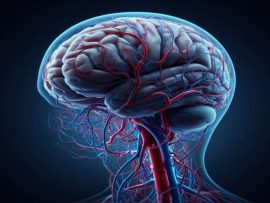Abstract Clinical practice guidelines (CPGs) are essential documents offering practical recommendations developed to enhance patient care and inform health care. Properly formulated through meticulous assessment of scientific evidence and medical..
Lee masAbstract Adult cardiac surgery is an essential therapeutic approach to reduce short- and long-term mortality and morbidity in patients with acute or chronic cardiac diseases. The outcomes after cardiac surgery..
Lee masAbstract The burden of neurologic diseases, including stroke and dementia, is expected to grow substantially in the coming decades. Thus, achieving optimal brain health has been identified as a public..
Lee masAbstract Background: Photoplethysmography (PPG) is a technology routinely used in clinical practice to assess blood oxygenation (SpO2) and pulse rate (PR). Skin pigmentation may influence accuracy, leading to health outcomes..
Lee masAbstract Despite abundant clinical innovation and burgeoning scientific investigation, pulmonary embolism (PE) has continued to pose a diagnostic and management challenge worldwide. Aging populations, patients living with a mounting number..
Lee masAbstract Cardiogenic shock (CS) is one of the most challenging areas in cardiology, where hard evidence is often limited. Several factors contribute to this scarcity. Patients with CS are typically..
Lee masAbstract BACKGROUND: Different preparations of fibrinogen concentrate are currently available. Two in vitro studies demonstrated the superiority of FibCLOT (LFB) in increasing clot firmness with respect to RiaSTAP (CSL Behring)...
Lee masVentilation and Oxygenation During and After Adult Cardiopulmonary Resuscitation: Changing Paradigms
Abstract Cardiac arrest (CA) remains a major cause of death despite advancements in cardiopulmonary resuscitation (CPR), post-resuscitation care, and international efforts to develop evidence-based guidelines. Effectively managing ventilation and oxygenation..
Lee masAbstract Objective We aimed to determine if machine learning can predict acute brain injury and to identify modifiable risk factors for acute brain injury in patients receiving venoarterial extracorporeal membrane..
Lee masAbstract Background Interprofessional simulation-based team training (ISBTT) is commonly used to optimize interprofessional teamwork in healthcare. The literature documents the benefits of ISBTT, yet effective interprofessional collaboration continues to be..
Lee masAbstract A 31-year-old woman at 41 weeks gestation presented after a home-delivery attempt, resulting in an intrauterine fetal demise. A cesarean section revealed purulent amniotic fluid. The patient had a..
Lee masAbstract Background Extracorporeal membrane oxygenation (ECMO) is an advanced medical technology that is used to treat respiratory and heart failure. The U.S. military has used ECMO in the care of..
Lee masAbstract OBJECTIVES: To identify and prioritize research questions for anticoagulation and hemostasis management of neonates and children supported with extracorporeal membrane oxygenation (ECMO) from the Pediatric ECMO Anticoagulation CollaborativE (PEACE)..
Lee masAbstract OBJECTIVES: To derive systematic-review informed, modified Delphi consensus regarding the medications used for anticoagulation for pediatric extracorporeal membrane oxygenation (ECMO) for the Pediatric ECMO Anticoagulation CollaborativE (PEACE). DATA SOURCES: ..
Lee masAbstract Background: Little is known about extracorporeal membrane oxygenation (ECMO)-related spinal cord infarction (SCI), and reports regarding this rare and catastrophic complication are rare. Here, we report two cases of..
Lee masAbstract This study investigates the prevalence and risk factors associated with venous thrombotic events in patients receiving (ECMO) support. Systematic review and meta-analysis of case-control and cohort studies. PubMed, Cochrane..
Lee masAbstract Background: Patients maintained on extracorporeal membrane oxygenation (ECMO) often require systemic anticoagulation to prevent circuit clotting and systemic thromboembolic complications. The optimal intensity of anticoagulation to balance the risk..
Lee masAbstract Background/Objectives: This study evaluated the hemostatic performance and safety of ActiClot (ATC), a new flowable hemostatic agent, through in vivo tests. Methods: ATC was compared with the commercially available..
Lee masAbstract Background: Veno-venous extracorporeal membrane oxygenation (VV-ECMO) is a critical intervention for patients with severe lung failure, especially acute respiratory distress syndrome (ARDS). The weaning process from ECMO relies largely..
Lee masAbstract Introduction In children requiring venoarterial (VA) extracorporeal membrane oxygenation (ECMO) for long durations, conversion to venovenous (VV) support may be advantageous. The purpose of this study was to evaluate..
Lee masAbstract Summary Cardiogenic shock is a complex syndrome defined by systemic hypoperfusion and inadequate cardiac output arising from a wide array of underlying causes. Although the understanding of cardiogenic shock..
Lee masAbstract OBJECTIVES: Extracorporeal cardiopulmonary resuscitation (ECPR) serves as a lifesaving intervention for patients experiencing refractory cardiac arrest. With its expanding usage, there’s a burgeoning focus on improving patient outcomes through..
Lee masAbstract IMPORTANCE: “Awake” cannulation for venovenous extracorporeal membrane oxygenation (ECMO), where patients remain spontaneously breathing without invasive mechanical ventilation during the cannulation procedure, may reduce lung injury from positive pressure..
Lee masAbstract Background Pediatric cardiac transplant recipients undergo elective cardiac catheterization and endomyocardial biopsy (CC/EMB) for graft dysfunction surveillance often facilitated by general anesthesia (GA). GA and positive pressure ventilation (PPV)..
Lee masAbstract Recent studies suggest that heparan sulfate proteoglycans (HSPG) contribute to the predisposition to, protection from, and potential treatment and prevention of Alzheimer’s disease (AD). Here, we used electronic health..
Lee masAbstract Background: Cold-induced RNA binding protein (CIRBP) is widely involved in critical physiological processes of myocardial fibrosis (MF), a crucial mechanism of cardiac insufficiency in myocardial infarction (MI). However, whether CIRBP..
Lee masAbstract Background: Extracorporeal membrane oxygenation (ECMO) is associated with significant inflammatory reactions that can impact patient outcomes. This meta-analysis aimed to evaluate the impact of ECMO on the functional ability of..
Lee masAbstract This study focuses on understanding the influence of cognitive biases in the intra-operative decision-making process within cardiac surgery teams, recognizing the complexity and high-stakes nature of such environments. We..
Lee masAbstract Objectives This study was designed to compare individualized and conventional hyperglycemic thresholds for the risk of (AKI) after cardiac surgery. Design This was an observational study. Setting The study took..
Lee masAbstract Background: Hydroxocobalamin increases systemic blood pressure through nitric oxide pathway suppression. However, its effects on hypotension during extracorporeal membrane oxygenation (ECMO) are unknown. The objective of this study was to..
Lee mas

















